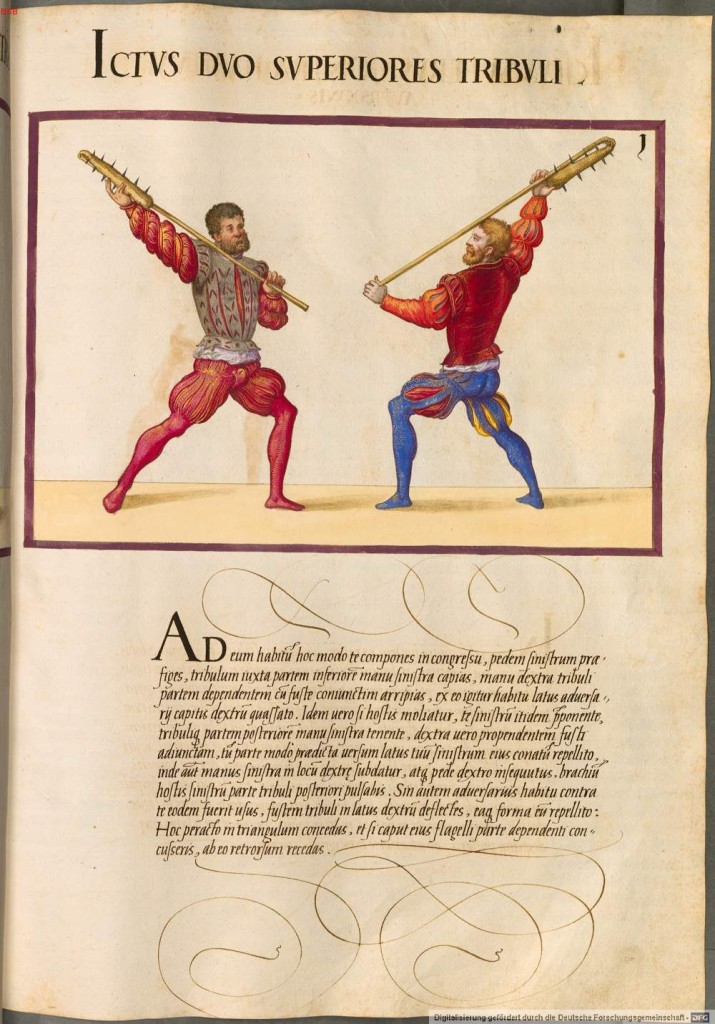Translation by Rachel Barkley
Two Upper Strokes of the Flail
According to this stance, you will position yourself in this manner in the fight. You will fix[1] forward the left foot. You will grasp the flail around the lower part with the left hand. You will seize the hanging part of the flail together with the flail-body with the right. From this position, strike the right side of your adversary’s head.
If your enemy attempts the same blow, with you positioning the left foot in the same way and with the left hand gripping the lower part of the flail and clutching the hanging of the flail-head with the right, then with the part of the flail mentioned beforehand[2] repel his attack you turning him to your left flank. After that, the left hand is to go in the place of the right and you, pursuing him with your right foot, will attack the left limb of the enemy with the lower part of the flail.
If however the adversary has used the same position against you, you will deflect the head of the flail against the right flank and repel him by this form: You will pass over a triangle[3] by completing it, and if you will have struck his head with the hanging part of the flail you should withdraw backwards from him.
NOTES:
[1]Here praefiges is translated as “fix”. Instances of praepones in the text are translated as “place”. The difference seems to be that a “fixed” foot will not be the first to move, whereas a “placed” foot will
[2]Here praedicta is translated as “mentioned beforehand” and refers to the immediately referred to part in all instances except one, in Plate 8.
[3]In triangulum concedos, or “step in a triangle”.
Interpretation by Owen Townes
Setup:
Agente & Patiente
High Guard with wide grip, holding flail heads, left feet forward and planted
Play:
Agente
Offside oberhau to Patiente’s head
Patiente
Catch the strike with flail-head (still held), deflect over head and down to the ground, ending in left-side Scales
Exchange hands
Pass right foot forward and strike with buttspike
Agente
Raise back hand to form Scales guard and deflect Patiente’s attack to right side
Step in a triangle to strike head and withdraw
Observations:
Grasping the head enables Agente to strike to the offside from high guard with out risking striking himself in the head during the swing
Patiente’s grip on the head enables him to block with the upper part of the staff rather than the lower (as is seen in most of the plays)
The sided-ness of Agente’s triangle step to end the fight is not specified, but it seems that a triangle step to the left would be the better option
The default to Scales guard for defense is already illustrated here in Agente’s reaction: It’s much easier to simply raise the staff and block with it, leaving the head on the ground, than to try to move that much weight at the end of the six foot staff. Also, it’s worth noting that this action requires very careful understanding of tempo, as it amounts to a deflection intercepting a strike (like Fiore’s fourth wide play).
Also demonstrated, the significant preference of deflections over static blocks. Patiente’s initial response seemed awkward at first as it involves a well-timed catch from behind of the incoming strike, leveraging it up and all the way down, but the alternative, intercepting the strike and stopping it, risks the flail-head wrapping around to connect to Patiente’s head. Throughout the instructions, only a handful of static blocks are seen, and almost all are opposing the staff to the incoming flail head rather than the incoming staff.

Leave a Reply